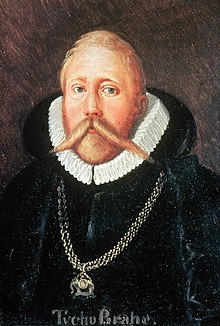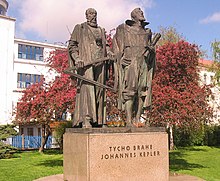Tycho Brahe
Tycho Brahe (14 December 1546 — 24 October 1601) was an astronomer from Denmark.[1] He observed the night sky before the invention of the telescope. With money from the King of Denmark he built a large observatory called Uraniborg on the island of Hven in Denmark.
Tycho Brahe | |
|---|---|
 Brahe wearing the Order of the Elephant | |
| Born | Tyge Ottesen Brahe 14 December 1546 |
| Died | 24 October 1601 (aged 54) |
| Nationality | Danish |
| Alma mater | University of Copenhagen Leipzig University University of Rostock |
| Occupation(s) | Nobleman, astronomer, writer |
| Known for | Tychonic system Rudolphine Tables |
| Spouse | Kirsten Barbara Jørgensdatter |
| Children | 8 |
| Parent(s) | Otte Brahe Beate Clausdatter Bille |
| Signature | |
 | |

He discovered that the universe outside the Solar System could change when he studied a supernova and a comet. Johannes Kepler was his assistant. Tycho made very careful observations of the planets. When Tycho died in 1601, Kepler continued Tycho's work.
Tycho was not a modern scientist. He believed in astrology, and his astronomy was a strange mixture of scientific observation and religious belief. Although he rejected the Ptolemaic system, he also rejected the Copernican system.[2][3] He developed a geocentric theory that imagined the Sun and Moon orbited the Earth, but the other planets orbited the Sun.
Unlike most astronomers of his time, he did not believe in the unchanging celestial realm or spheres. Tycho's Nova, now called SN 1572, proved that changes did take place. Also, he worked out that comets were real celestial objects, and that their orbits were different from those of the planets.
Related pages change
References change
Other websites change
- Tycho Brahe – Accomplishments, Biography, & Facts. Encyclopædia Britannica